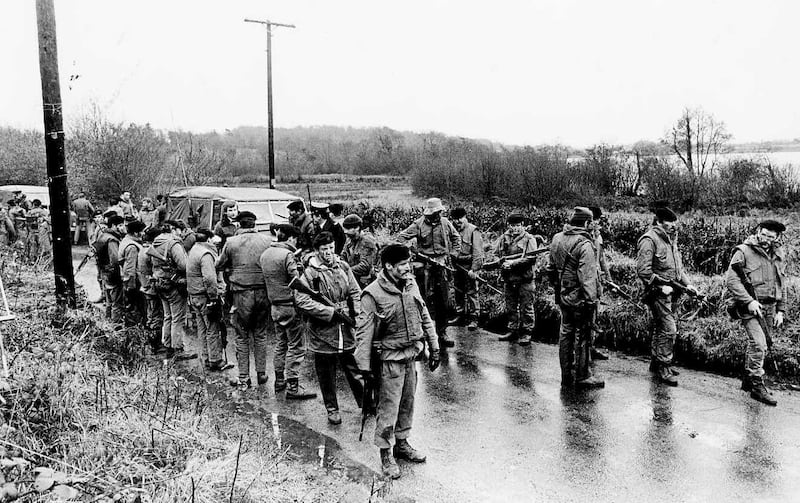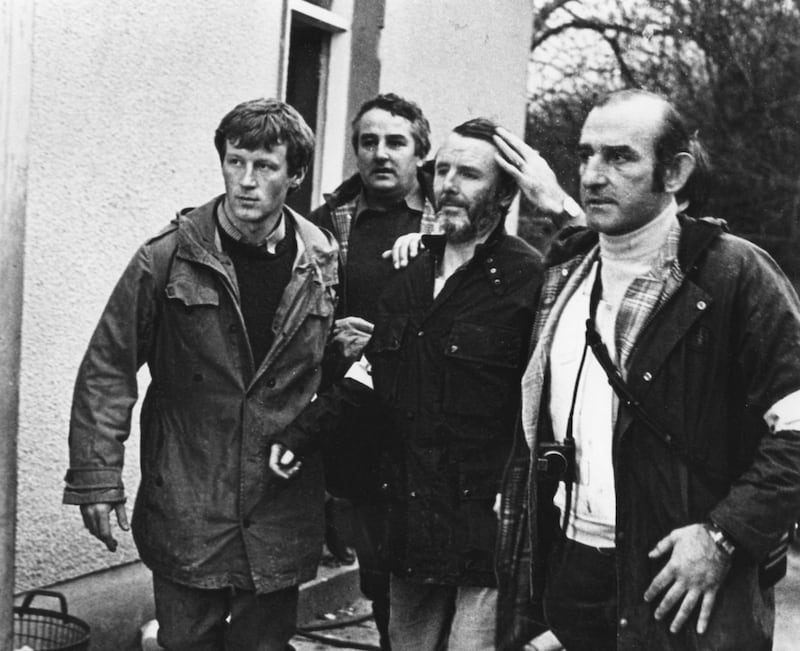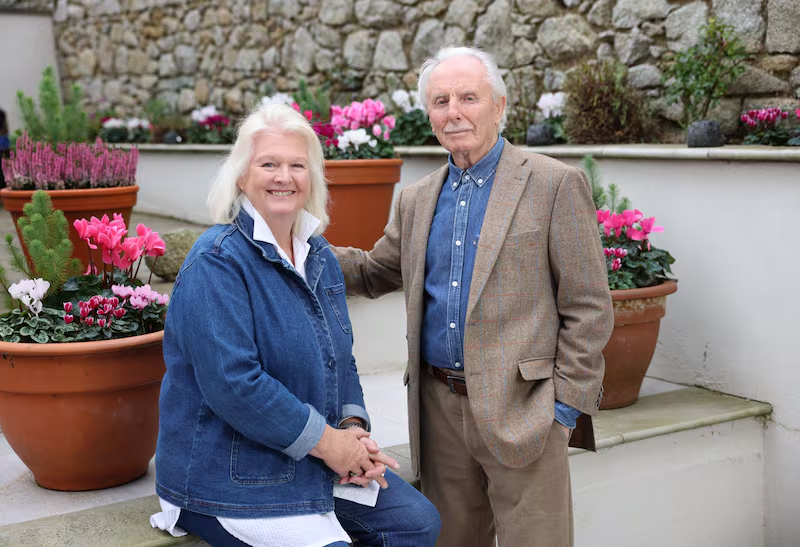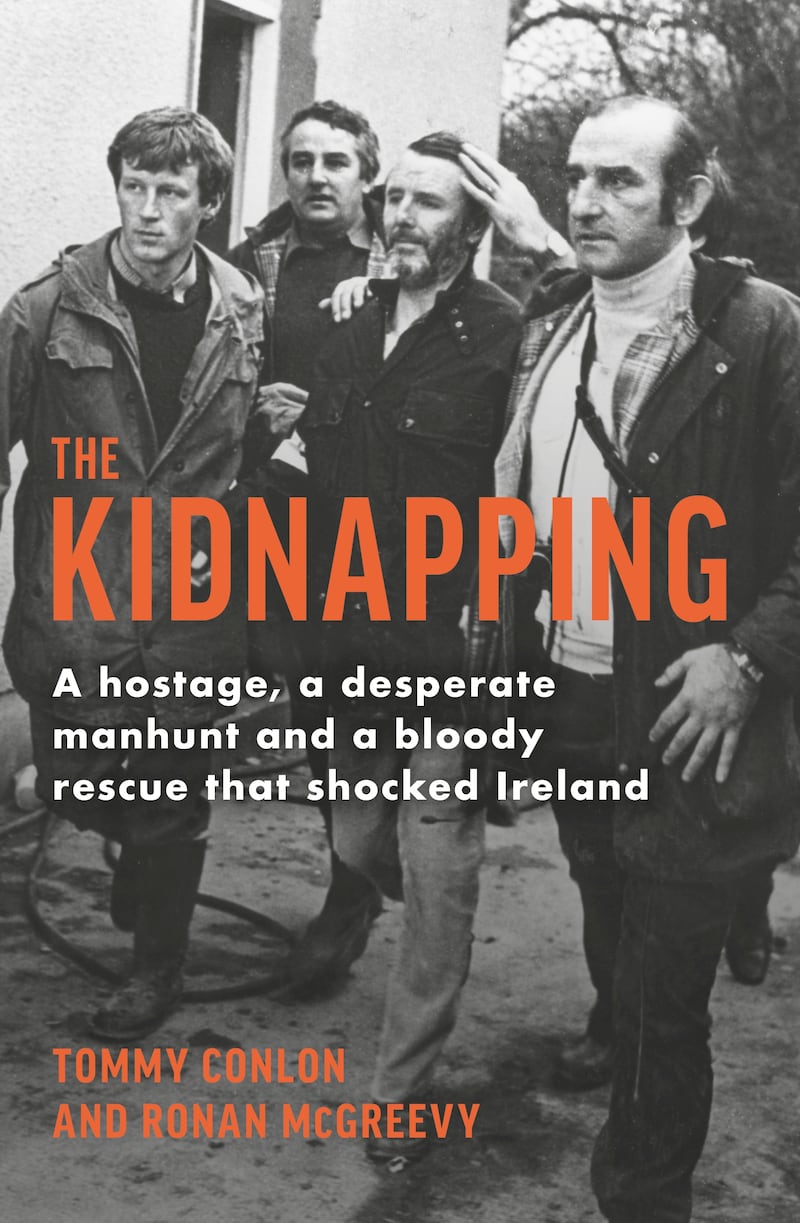Through the clump of pine trees, Recruit Garda Tom Barrett could see the silhouettes of two men crouched down with guns. They appeared to be wearing military-style clothing. Recruit Garda Francis Smith could see them too. One of the men was cleaning a rifle with a white cloth.
Smith took in the scene for a second before breaking the silence. “Soldier! Answer my call,” he shouted. There was no reply.
Another garda recruit, Gary Sheehan, was standing a few yards away from Smith. “Is that you, Frank?” he asked him. “Yes,” replied Smith, who then checked if there was a soldier with him. There was.
Sheehan then addressed one of the gunmen in the clearing. “Can you answer, soldier?” Again, no reply. He turned to his supervisor, Sergeant Liam Wall, who was watching from a raised embankment some yards behind him. “Sergeant, there’s a man here and he won’t speak to us,” he told Wall.
READ MORE
It was 2.30pm on Friday, December 16th, 1983, and the light was fading fast. The sky was grey with rain clouds. As far as the eye could see, uniformed men were beating at the sodden earth with metal probes and swatting aside thick undergrowth in the search for a man who had been missing for 23 days.
Occasionally, an Irish army Alouette helicopter appeared overhead. Ten search teams comprising soldiers and gardaí were scouring the forested uplands some five miles north of Ballinamore, Co. Leitrim, close to the Cavan border.

In the distance was Sliabh an Iarainn, the Iron Mountain, the highest point in south Leitrim. Its iron deposits were long gone, and so were most of the people.
Further north were the dark hills of the Cuilcagh Mountains. This was rough, poor land, deemed fit for little other than sheep and trees. Those who stayed were engaged in an attritional battle against the thin topsoil and the heavy rains which turned the land to a gluey daub every spring.
The search teams combed the area, one for every mile radius from the centre of Ballinamore, which had become the headquarters for what was the largest operation of its kind in the history of the State
Yet this part of Leitrim could grow Sitka spruce like few places in Europe. But in the long hiatus between planting and harvesting, the people left and the trees grew unhampered.
The fields between the patchwork of forests and the unkempt woods were small, wet and full of rushes. Barely passable lanes linked the planted forests, which were typically between 20 and 30 acres in size. The trees were grown for the commercial timber industry and intended to yield a supplementary income for hard-pressed local farmers. The search teams combed the area, one for every mile radius from the centre of Ballinamore, which had become the headquarters for what was the largest operation of its kind in the history of the State.
What had started out as a wide-sweeping search had now funnelled down to a patch of terrain that was microscopic on maps, and so remote it would rarely have been visited even by locals. To get there, the security forces had to take the minor road out of Ballinamore, then turn on to a side road barely wide enough for cars to pass each other, and veer off that side road on to hillside passes no wider than country lanes. Finally, there was no road at all, just forests and fields and rural silence. A few farmhouses were nestled here and there in the landscape, peopled by families well used to the elements and to hardship. The search was unofficially named Operation Santa Claus, a festive title that belied its seriousness.

A man’s life was at stake, and so too was the reputation of the Irish State when it came to dealing with its greatest national security threat – the Provisional IRA. The media were diligently tracking every twist and turn of a drama that had already been running for over three weeks. The search parties were each allocated the name “Rudolph” and a number from one to 10. The man they had come to rescue was Don Tidey, a British-born supermarket executive who had been kidnapped from his car while bringing his daughter to school in south Co Dublin on the morning of 24 November. The businessman was being held hostage in a small hillside wood about two and a half acres in size that comprised young pines some 15 feet high with multiple protruding branches, making for a densely camouflaged location.
It was known locally as Drumcroman Wood but would quickly become familiar nationwide as Derrada Wood after the local post office address. Access was hindered by high tangles of briars. Even in broad daylight it was a dark and gloomy place. On a dank December afternoon, the winter light was weaker still. The searchers were moving around in semi-darkness. They could not use torches in case they alerted the kidnappers, if, indeed, the kidnappers were in there.
After several days of relative tranquillity in their bolthole, a crisis was looming. The kidnappers could also hear the search parties closing in. They would have to make a decision: fight or flight?
Rudolph 5 had 24 men in its group that day. They were operating at a considerable distance from the other search parties. Occasionally its members drifted apart from each other, losing touch with the people left and right, becoming disorientated by the forest darkness or separated by the uneven ground and protruding branches and continuing their arduous progress, not knowing they were about to walk straight into the gang’s lair. It was a lair that had been prepared well in advance of the abduction.
The chosen hide was a hollow in the ground at the base of some trees. Its surface was covered by black polythene, lined with straw, while overhead it was sheltered by sheets of black plastic tethered to tree trunks and blanketed in leaves and twigs. This was where the IRA gang and their captive ate, slept and washed. They toileted nearby. After several days of relative tranquillity in their bolthole, a crisis was looming. The kidnappers could also hear the search parties closing in. They would have to make a decision: fight or flight?
They’d been hearing the gardaí and soldiers roaming through the hinterland for a number of days; the engines of cars and army trucks, the rotors of the helicopter hovering in the sky. The gang knew they were being surrounded; their refuge was mutating into a trap. And now the voices were getting closer. It was time to leave.
Their hostage was forced at gunpoint to his feet. The kidnappers removed his hood and replaced it with a balaclava. They took his shackles off and told him to follow them once they gave the order. Meanwhile, the Rudolph 5 search party was closing in a V shape on Derrada Wood. It consisted of a garda inspector, a sergeant, four detectives, two uniformed gardaí, 10 recruit gardaí and six soldiers. The soldiers had standard-issue FN rifles, and five of the policemen were armed with Uzi machine guns; the rest were unarmed. The men at either end of the formation had radios to call back to the centre of the operation – Echo Base in Ballinamore.
The search team entered the wood, eyes adjusting to the darkness as they pushed through the branches, droplets of water falling on them from the heights of the trees. Then Recruit Garda Barrett stopped in his tracks, frozen by the tableau he saw ahead: a black plastic covering, stretched and knotted between tree trunks; camping equipment, food litter and other detritus. There was human activity here. He drew back immediately to inform the others. The realisation brought a chilling frisson to the members of Rudolph 5: this was the place.
Sgt Wall, who was in charge of the Rudolph 5 garda recruits, was now lying flat on a raised bank. He turned his body to address the recruit gardaí waiting to advance. “Be careful,” he murmured, “there are men with guns in there”.
[ The kidnapping of Don Tidey: a bloody wake-up call for the StateOpens in new window ]
Some members of Rudolph 5 then spotted the two armed men in flak jackets and balaclavas. But were they friend or foe? Army Rangers personnel involved in the search were also wearing military fatigues and had blackened faces. One gunman was holding a rifle pointed upwards, the other was kneeling with his weapon pointing down.
The air was suddenly dense with tension and fear. Then Smith and Sheehan broke the silence, before the latter turned to Wall: “Sergeant, there’s a man here and he won’t speak to us.” Almost instantaneously, a shattering burst of semi-automatic machine-gun fire rang out. The situation had transformed in an instant. Recruit Garda Gary Sheehan fell immediately. Another burst of fire felled a soldier, Private Patrick Kelly, just as he was getting into a crouched position to fire back. Neither man had a chance; both had been raked with bullets.
Many years later Garda Sergeant Joe O’Connor, a trainee on the day, would recall the fateful moment in court. “I heard a groan or grunt where Garda Sheehan had been,” he said, recalling that the young recruit’s feet went from under him as blood poured from multiple wounds; his cranium was shattered by a bullet and his brain exposed.
The 23-year-old, who had begun garda training only three months earlier, died instantly. His garda cap, fastened by its chinstrap, remained on his head. Patrick Kelly, thirty-five and a father of four, was shot with a line of bullets from ankle to head and fell backwards. Kelly did not die instantly; he slowly bled to death. His comrades heard him plead: “Please don’t leave me, I’m not going to make it.”
The kidnappers followed up their gun attack by detonating a stun grenade, designed to cause confusion and terror. It made such a noise that gardaí and soldiers thought a bomb had exploded. Taking advantage of the stunned reaction, the gang moved in on three soldiers at gunpoint and ordered them to disarm. One of them was Shine. “I thought [these] people were desperate enough to get out that they would have shot me as well,” he would recall.
Paul Gillen was 19, a garda recruit from Dublin’s inner city. He could feel the nozzle of an assault rifle in the small of his back. ‘Don’t be a dead hero. We shot one of you, we’ll shoot again,’ a gunman told him
One gunman put his rifle to the back of Shine’s head and ordered him to instruct his fellow soldiers not to shoot. Shine put his hands in the air and shouted, “Don’t shoot, don’t shoot.” He was pushed forward and told to run. The gang now took the soldiers’ weapons. Members of the Irish Army, officially known in the Irish language as Óglaigh na hÉireann, were now being held at gunpoint by men who believed themselves to be the true and rightful Óglaigh na hÉireann. Next the gang seized Denis Breen, a Ballinamore-based garda, and a number of garda recruits and made them walk in front of them, along with the captured soldiers, as human shields.
One of the recruits was Francis Morgan, who had dropped to the ground in the mayhem. He saw eight or nine people coming out of the trees, three of them wearing combat gear and carrying rifles and submachine guns. A garda and two soldiers were lying beside him. A gunman ordered them to stand up. “Dead heroes no good,” he warned them.
Paul Gillen was 19, a garda recruit from Dublin’s inner city. He could feel the nozzle of an assault rifle in the small of his back. “Don’t be a dead hero. We shot one of you, we’ll shoot again,” a gunman told him in a Northern accent. Next the gardaí and soldiers were ordered to start running across a field with their hands held high. Behind the captive gardaí and soldiers the kidnappers kept their weapons cocked. As they came to a fence, one pointed a gun in Shine’s face and ordered him to provide help crossing it.

Shine pulled him over the fence. At one stage Morgan became aware of an armed detective to his right and one of the gunmen firing a volley of shots in the detective’s direction. Meanwhile, in the kidnappers’ panic to get away, they’d abandoned the man who was at the centre of the entire drama and provided him with an opportunity. “There was a burst of gunfire,’ Don Tidey would recall later. “Then more gunfire and, frankly, from that moment on, it became a battleground. Once firing had broken out, everybody made their own arrangements.”
This is an extract from The Kidnapping: A hostage, a desperate manhunt and a bloody rescue that shocked Ireland by Tommy Conlon and Ronan McGreevy is published by Penguin Sandycove, priced €17.99.

· Sign up for push alerts and have the best news, analysis and comment delivered directly to your phone
· Find The Irish Times on WhatsApp and stay up to date
· Our In The News podcast is now published daily – Find the latest episode here

















